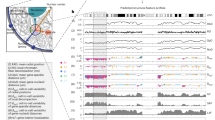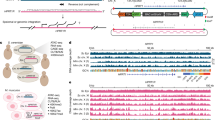Abstract
The distribution of genes on eukaryotic chromosomes is nonrandom, but the reasons behind this are not well understood. The commonly observed clustering of essential genes is a case in point. Here we model and test a new hypothesis. Essential proteins are unusual in that random fluctuations in abundance (noise) can be highly deleterious. We hypothesize that persistently open chromatin domains are sinks for essential genes, as they enable reduced noise by avoidance of transcriptional bursting associated with chromatin remodeling. Simulation of the model captures clustering and correctly predicts that (i) essential gene clusters are associated with low nucleosome occupancy (ii) noise-sensitive nonessential genes cluster with essential genes (iii) nonessential genes of similar knockout fitness are physically linked (iv) genes in domains rich in essential genes have low noise (v) essential genes are rare subtelomerically and (vi) essential gene clusters are preferentially conserved. We conclude that different noise characteristics of different genomic domains favors nonrandom gene positioning. This has implications for gene therapy and understanding transgenic phenotypes.
This is a preview of subscription content, access via your institution
Access options
Subscribe to this journal
Receive 12 print issues and online access
$209.00 per year
only $17.42 per issue
Buy this article
- Purchase on SpringerLink
- Instant access to full article PDF
Prices may be subject to local taxes which are calculated during checkout




Similar content being viewed by others
References
Hurst, L.D., Pal, C. & Lercher, M.J. The evolutionary dynamics of eukaryotic gene order. Nat. Rev. Genet. 5, 299–310 (2004).
Fischer, G., Rocha, E.P.C., Brunet, F., Vergassola, M. & Dujon, B. Highly variable rates of genome rearrangements between hemiascomycetous yeast lineages. PLoS Genet. [online] 2, e32 (2006) (10.1371/journal.pgen.0020032).
Gerdes, S.Y. et al. Experimental determination and system level analysis of essential genes in Escherichia coli MG1655. J. Bacteriol. 185, 5673–5684 (2003).
Kamath, R.S. et al. Systematic functional analysis of the Caenorhabditis elegans genome using RNAi. Nature 421, 231–237 (2003).
Pal, C. & Hurst, L.D. Evidence for co-evolution of gene order and recombination rate. Nat. Genet. 33, 392–395 (2003).
Hentges, K.E., Pollock, D.D., Liu, B. & Justice, M.J. Regional variation in the density of essential genes in mice. PLoS Genet. [online] 3, e72 (2007) (10.1371/journal.pgen.0030072).
Cook, D.L., Gerber, A.N. & Tapscott, S.J. Modeling stochastic gene expression: implications for haploinsufficiency. Proc. Natl. Acad. Sci. USA 95, 15641–15646 (1998).
Newman, J.R. et al. Single-cell proteomic analysis of S. cerevisiae reveals the architecture of biological noise. Nature 441, 840–846 (2006).
Fraser, H.B., Hirsh, A.E., Giaever, G., Kumm, J. & Eisen, M.B. Noise minimization in eukaryotic gene expression. PLoS Biol. [online] 2, e137 (2004) (10.1371/journal.pbio.0020137).
Deutschbauer, A.M. et al. Mechanisms of haploinsufficiency revealed by genome-wide profiling in yeast. Genetics 169, 1915–1925 (2005).
Becskei, A., Kaufmann, B.B. & van Oudenaarden, A. Contributions of low molecule number and chromosomal positioning to stochastic gene expression. Nat. Genet. 37, 937–944 (2005).
Raj, A., Peskin, C.S., Tranchina, D., Vargas, D.Y. & Tyagi, S. Stochastic mRNA synthesis in mammalian cells. PLoS Biol. [online] 4, e309 (2006) (10.1371/journal.pbio.0040309).
Raser, J.M. & O'Shea, E.K. Noise in gene expression: origins, consequences, and control. Science 309, 2010–2013 (2005).
Lee, C.K., Shibata, Y., Rao, B., Strahl, B.D. & Lieb, J.D. Evidence for nucleosome depletion at active regulatory regions genome-wide. Nat. Genet. 36, 900–905 (2004).
Seoighe, C. et al. Prevalence of small inversions in yeast gene order evolution. Proc. Natl. Acad. Sci. USA 97, 14433–14437 (2000).
Maillet, L. et al. Evidence for silencing compartments within the yeast nucleus: a role for telomere proximity and Sir protein concentration in silencer-mediated repression. Genes Dev. 10, 1796–1811 (1996).
Knop, M. Evolution of the hemiascomyclete yeasts: on life styles and the importance of inbreeding. Bioessays 28, 696–708 (2006).
Batada, N.N., Urrutia, A.O. & Hurst, L.D. Chromatin remodeling is a major source of co-expression of linked genes in yeast. Trends Genet. (in the press).
Nei, M. Modification of linkage intensity by natural selection. Genetics 57, 625–641 (1967).
Spellman, P.T. & Rubin, G.M. Evidence for large domains of similarly expressed genes in the Drosophila genome. J. Biol. 1, 5 (2002) (doi:10.1186/1475-4924-1-5).
Gilbert, N., Boyle, S., Fiegler, H., Woodfine, K., Carter, N.P. & Bickmore, W.A. Chromatin architecture of the human genome: gene-rich domains are enriched in open chromatin fibers. Cell 118, 555–566 (2004).
Amsterdam, A. et al. Identification of 315 genes essential for early zebrafish development. Proc. Natl. Acad. Sci. USA 101, 12792–12797 (2004).
Krylov, D.M., Wolf, Y.I., Rogozin, I.B. & Koonin, E.V. Gene loss, protein sequence divergence, gene dispensability, expression level, and interactivity are correlated in eukaryotic evolution. Genome Res. 13, 2229–2235 (2003).
Gustafson, A.M., Snitkin, E.S., Parker, S.C.J., DeLisi, C. & Kasif, S. Towards the identification of essential genes using targeted genome sequencing and comparative analysis. BMC Genomics 7, 265 (2006) (doi:10.1186/1471-2164-7-265).
Giaever, G. et al. Functional profiling of the Saccharomyces cerevisiae genome. Nature 418, 387–391 (2002).
Acknowledgements
N.B. is funded by a fellowship from the Canadian Institutes for Health Research.
Author information
Authors and Affiliations
Ethics declarations
Competing interests
The authors declare no competing financial interests.
Supplementary information
Supplementary Text and Figures
Supplementary Figures 1–3, Supplementary Tables 1–3, Supplementary Methods, Supplementary Discussion (PDF 591 kb)
Rights and permissions
About this article
Cite this article
Batada, N., Hurst, L. Evolution of chromosome organization driven by selection for reduced gene expression noise. Nat Genet 39, 945–949 (2007). https://doi.org/10.1038/ng2071
Published:
Issue Date:
DOI: https://doi.org/10.1038/ng2071



